Umbria, the pretty, rural region in central Italy just south of Tuscany, is known for its sleepy Medieval hilltowns, which spend almost the entire year caught in a time capsule of languid days broken up by long family meals and gossip in the main square which has remained unchanged for centuries. I say almost the entire year, however, because this slow pace and pastoral atmosphere is brusquely interrupted once a year when each town holds its annual festival—most often celebrating the local patron saint’s feast day—and the citizens let their hair down for a few days of unfettered eating, drinking, dancing, and benignly chaotic partying.
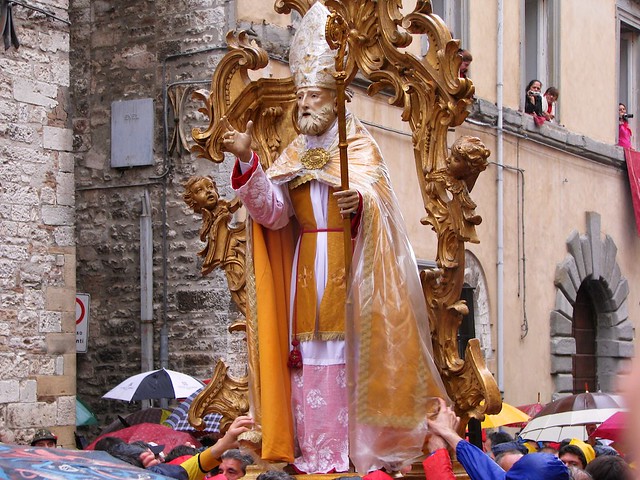
(Photo by Concierge in Umbria via Flickr)
Nowhere is the contrast between the saint’s day celebrations and the remaining 364 days of the year as dramatic as in Gubbio, where this normally stoic and rather dour mountain fortress town descends into a day of delightful madness and celebratory anarchy each year on May 15th to celebrate their patron Saint Ubaldo with a symbolic race, La Corsa dei Ceri.
Tweetable: Spoiler alert: the same team has won Gubbio’s I Ceri race for the past 1000 years.
The History
“Ceri” technically means candles, though the three ceri used for this race are actually towering octogonal wooden columns, almost 5 meters high and weighing almost 300 kilograms, which are topped with small statues of the three saints “competing” in the race: Ubaldo (patron saint of Gubbio and protector of masons), Giorgio (protector of merchants), and Antonio (protector of farmers). These massive structures are carried on a litter by three teams of porters, or ceraioli, each dressed in the colors of their patron, who race from Gubbio’s main Piazza Grande through the streets of the town and up the slope of Mount Ingino to the Basilica of Saint Ubaldo above.
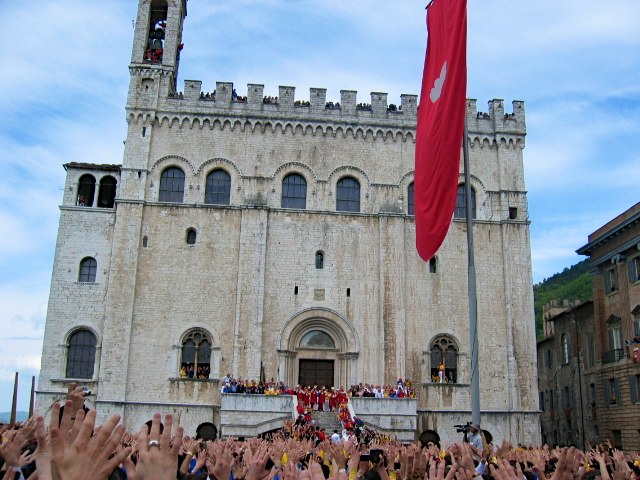
(Photo by Concierge in Umbria via Flickr)
This tradition, which began with the death of Gubbio’s Bishop Ubaldo Baldassini in 1160 and has been repeated each year since (indeed, “I Ceri” is such a heartfelt custom that Eugubini soldiers far from home reenacted the race in a number of far-flung battlefields during World War II), is a fusion of ancient pagan rites celebrating spring and a later Christian ritual of thanksgiving toward Gubbio’s patron Saint Ubaldo. In honor of the saint, despite the event being called a race, by tradition Team Ubaldo and his cero always wins, heralding a year of good fortune to the citizens of his town by entering the basilica first.
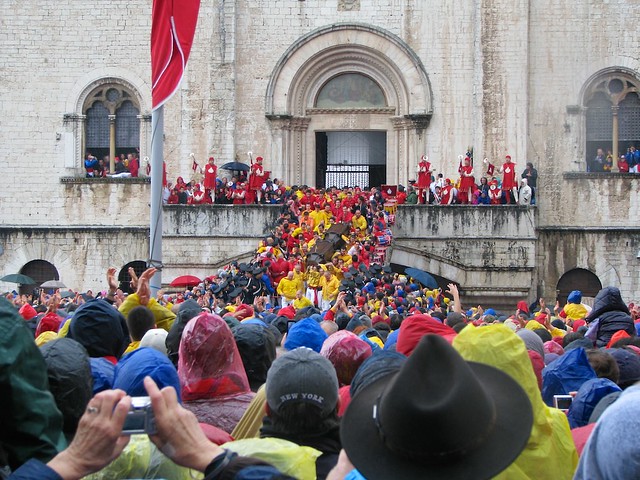
(Photo by Concierge in Umbria via Flickr)
Originally, large wax candles were used for the race, but were substituted in the 16th century with more durable wooden candle-shaped columns. Those used today, exact replicas of the original ceri, date from 1888 and were restored just three years ago. Though today any male citizen of Gubbio can be a ceraiolo porter, considered a great honor and rite of passage, historically ceraioli were extracted from each of the three trades protected by the individual saint and the honor was passed from father to son.
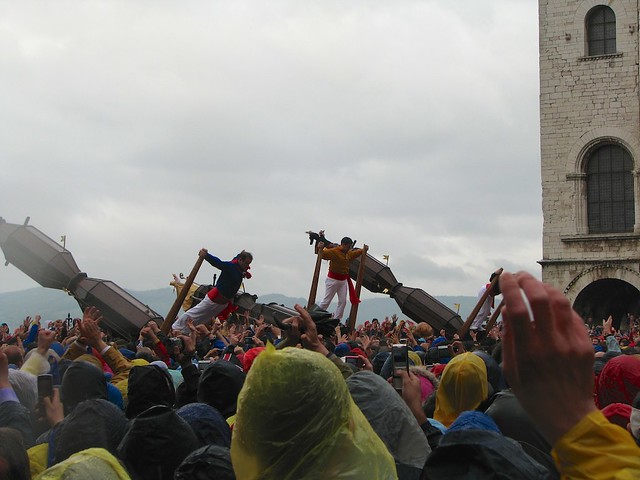
(Photo by Concierge in Umbria via Flickr)
The Race
The morning begins in Gubbio’s central Piazza Grande, packed shoulder to shoulder with locals and visitors witnessing the ceremonial start to the day’s festivities, marked by Medieval costumes, banners, and horn and drum fanfare. A roar rises from the crowd as the three massive ceri are raised by their bearers, and one begins to wonder how they will ever make it through the narrow streets (crowded with spectators) and up the steep side of the mountain. One will wonder for hours, as there is a long break for lunch for both the porters and the thousands jammed the town center, who fill the local restaurants and spill out into the streets. As the hours pass, the festive music gets louder, the festive wine flows, and the festive crowds are whipped into an increasingly bacchanal frenzy.
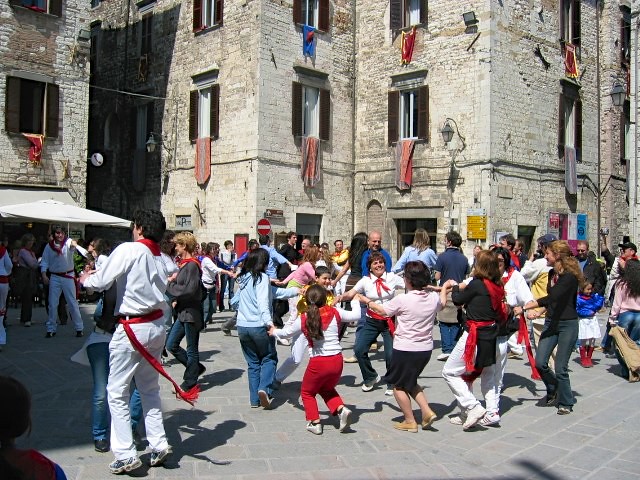
(Photo by Concierge in Umbria via Flickr)

(Photo by Concierge in Umbria via Flickr)
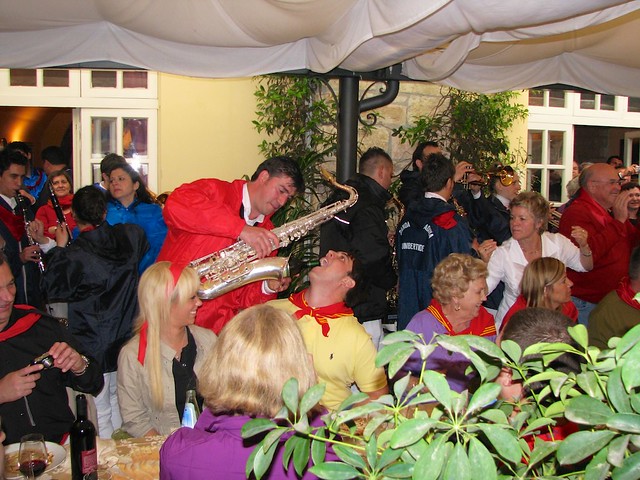
(Photo by Concierge in Umbria via Flickr)
At six in the evening, the three teams of ceraioli set off at top speed with their ceri on their backs, grunting and groaning (and frequently switching out individual porters along the route without slowing down) under the incredible weight of the precariously rocking columns along the two hour route. The starting order—Team Ubaldo followed by Team Giorgio and Team Antonio, respectively—remains unchanged along the route, as passing is taboo. So, too, is letting a cero fall…an incredibly traumatic event for that saint’s team which portends a year of bad luck.
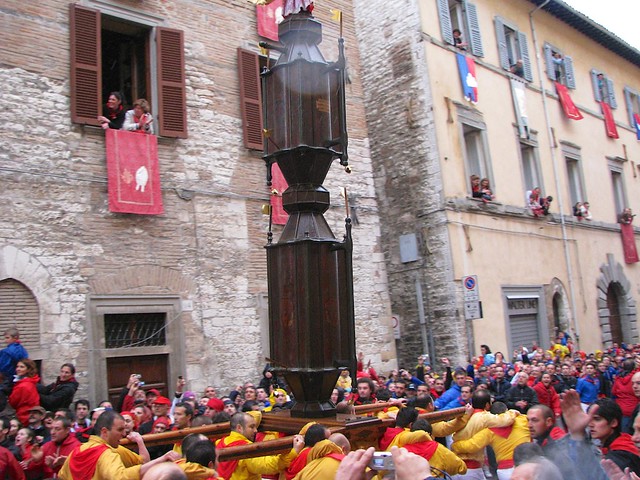
(Photo by Concierge in Umbria via Flickr)
The noise of the suffering porters is completely drowned out by the cacaphony from the crowd lining the route, as they scream encouragement (and, ahem, other things) for their ceraioli and saint of choice. The first, and perhaps most dangerous, stretch of the race has the teams set off steeply downhill preceded by a trumpeter and standard bearer on galloping horseback. Halfway through the race, there is a 15 minute break in Piazza Grande, until the mayor signals with a white handkerchief for the bells to toll and the race to set off again.

(Photo by Concierge in Umbria via Flickr)
The second half of the race is all uphill, and the panting and sweating ceraioli who are fighting to keep pace with each other and keep the ceri upright, are urged on by the noise of the spectators and the thought that the end is in sight. At the finish line—the Basilica of Saint Ubaldo—the ceraioli lower the ceri while still running so the tall columns can pass horizontally through the church’s main door.

(Photo by Concierge in Umbria via Flickr)
Tweetable: True to tradition, Gubbio’s I Ceri race is broken up by a five hour lunch break.
The Festivities
La Festa dei Ceri can be enjoyed by anyone, but is by far best experienced with a local guide by your side who can explain all the stages of the festival (which is, of course, exclusively in Italian) and the symbolic significance of the ceremony, knows the best (and worst) spots to watch and cheer along the route, and can help navigate the overflowing city center. Pushing 1000 years, I Ceri is one of the oldest and most deeply-felt festivals in all of Italy, and well-worth braving the friendly chaos that takes over Gubbio for the days surrounding the race!

(Photo by Concierge in Umbria via Flickr)
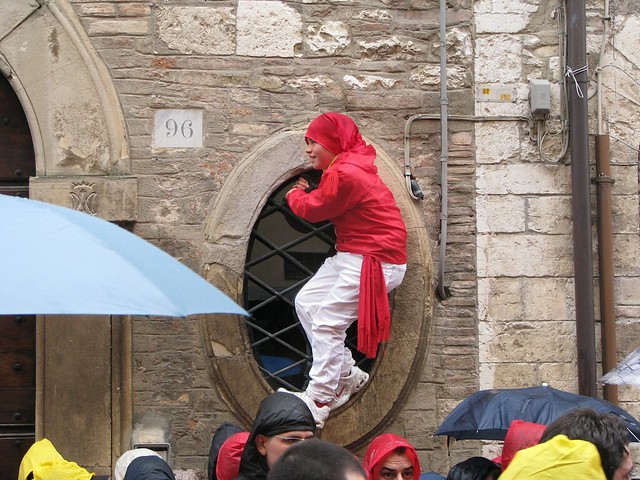
(Photo by Concierge in Umbria via Flickr)


